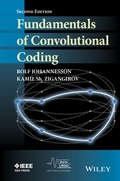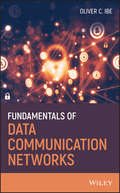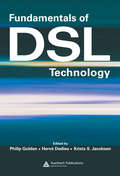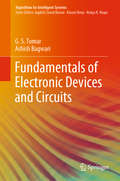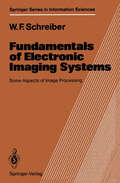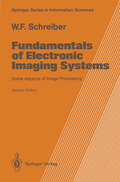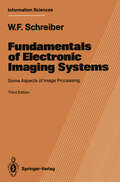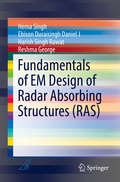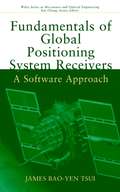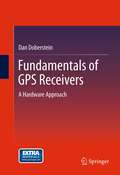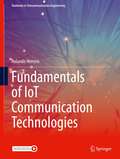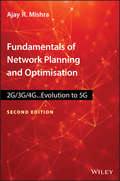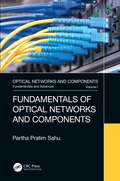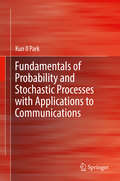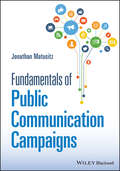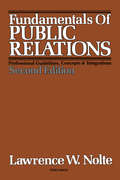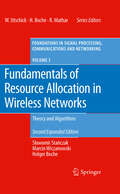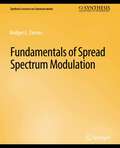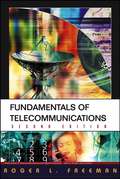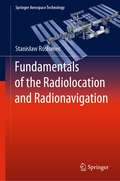- Table View
- List View
Fundamentals of Convolutional Coding (IEEE Series on Digital & Mobile Communication)
by Rolf Johannesson Kamil Sh. ZigangirovFundamentals of Convolutional Coding, Second Edition, regarded as a bible of convolutional coding brings you a clear and comprehensive discussion of the basic principles of this field Two new chapters on low-density parity-check (LDPC) convolutional codes and iterative coding Viterbi, BCJR, BEAST, list, and sequential decoding of convolutional codes Distance properties of convolutional codes Includes a downloadable solutions manual
Fundamentals of Convolutional Coding (IEEE Series on Digital & Mobile Communication)
by Rolf Johannesson Kamil Sh. ZigangirovFundamentals of Convolutional Coding, Second Edition, regarded as a bible of convolutional coding brings you a clear and comprehensive discussion of the basic principles of this field Two new chapters on low-density parity-check (LDPC) convolutional codes and iterative coding Viterbi, BCJR, BEAST, list, and sequential decoding of convolutional codes Distance properties of convolutional codes Includes a downloadable solutions manual
Fundamentals of Data Communication Networks
by Oliver C. IbeWhat every electrical engineering student and technical professional needs to know about data exchange across networks While most electrical engineering students learn how the individual components that make up data communication technologies work, they rarely learn how the parts work together in complete data communication networks. In part, this is due to the fact that until now there have been no texts on data communication networking written for undergraduate electrical engineering students. Based on the author’s years of classroom experience, Fundamentals of Data Communication Networks fills that gap in the pedagogical literature, providing readers with a much-needed overview of all relevant aspects of data communication networking, addressed from the perspective of the various technologies involved. The demand for information exchange in networks continues to grow at a staggering rate, and that demand will continue to mount exponentially as the number of interconnected IoT-enabled devices grows to an expected twenty-six billion by the year 2020. Never has it been more urgent for engineering students to understand the fundamental science and technology behind data communication, and this book, the first of its kind, gives them that understanding. To achieve this goal, the book: Combines signal theory, data protocols, and wireless networking concepts into one text Explores the full range of issues that affect common processes such as media downloads and online games Addresses services for the network layer, the transport layer, and the application layer Investigates multiple access schemes and local area networks with coverage of services for the physical layer and the data link layer Describes mobile communication networks and critical issues in network security Includes problem sets in each chapter to test and fine-tune readers’ understanding Fundamentals of Data Communication Networks is a must-read for advanced undergraduates and graduate students in electrical and computer engineering. It is also a valuable working resource for researchers, electrical engineers, and technical professionals.
Fundamentals of Data Communication Networks
by Oliver C. IbeWhat every electrical engineering student and technical professional needs to know about data exchange across networks While most electrical engineering students learn how the individual components that make up data communication technologies work, they rarely learn how the parts work together in complete data communication networks. In part, this is due to the fact that until now there have been no texts on data communication networking written for undergraduate electrical engineering students. Based on the author’s years of classroom experience, Fundamentals of Data Communication Networks fills that gap in the pedagogical literature, providing readers with a much-needed overview of all relevant aspects of data communication networking, addressed from the perspective of the various technologies involved. The demand for information exchange in networks continues to grow at a staggering rate, and that demand will continue to mount exponentially as the number of interconnected IoT-enabled devices grows to an expected twenty-six billion by the year 2020. Never has it been more urgent for engineering students to understand the fundamental science and technology behind data communication, and this book, the first of its kind, gives them that understanding. To achieve this goal, the book: Combines signal theory, data protocols, and wireless networking concepts into one text Explores the full range of issues that affect common processes such as media downloads and online games Addresses services for the network layer, the transport layer, and the application layer Investigates multiple access schemes and local area networks with coverage of services for the physical layer and the data link layer Describes mobile communication networks and critical issues in network security Includes problem sets in each chapter to test and fine-tune readers’ understanding Fundamentals of Data Communication Networks is a must-read for advanced undergraduates and graduate students in electrical and computer engineering. It is also a valuable working resource for researchers, electrical engineers, and technical professionals.
Fundamentals of DSL Technology
by Hervé Dedieu Krista S. Jacobsen Philip GoldenThe DSL arena is expanding rapidly, making it highly unlikely that any single author can adequately address the breadth and depth of the subject. Responding to the demand of designers worldwide, Fundamentals of DSL Technology combines the strengths of the field's most renowned DSL experts, providing a foundation of all aspects of DSL system design.
Fundamentals of Electronic Devices and Circuits (Algorithms for Intelligent Systems)
by G.S. Tomar Ashish BagwariThis book focuses on conceptual frameworks that are helpful in understanding the basics of electronics – what the feedback system is, the principle of an oscillator, the operational working of an amplifier, and other relevant topics. It also provides an overview of the technologies supporting electronic systems, like OP-AMP, transistor, filter, ICs, and diodes. It consists of seven chapters, written in an easy and understandable language, and featuring relevant block diagrams, circuit diagrams, valuable and interesting solved examples, and important test questions. Further, the book includes up-to-date illustrations, exercises, and numerous worked examples to illustrate the theory and to demonstrate their use in practical designs.
Fundamentals of Electronic Imaging Systems: Some Aspects of Image Processing (Springer Series in Information Sciences #15)
by William F. SchreiberImage processing is an applications area. In this area there are many op portunities to apply art and experience, as well as knowledge from various sciences and engineering disciplines, to the creation of products and pro cesses for which society has urgent need. Without this need, few would be interested in the subject. This point of view motivates this work and has influenced the selection and treatment of topics. It will be noticed that the word "digital" is not in the title. While much of present-day image processing is implemented digitally, this work is not intended for those who think that image processing is a branch of digital signal processing, except perhaps to try to change their minds. This book grew out of courses taught at the Massachusetts Institute of Technology by the author and two of his former students, T.S. Huang and O.J. Tretiak. Like the courses, it is primarily intended for electrical engineers and computer scientists who plan to work in the field. It has not proven necessary to spend much time on strictly digital issues, since the students either know that material already or can learn it very easily by 1 themselves. It also has been unnecessary to be encyclopedic, since Pratt has already performed this important service.
Fundamentals of Electronic Imaging Systems: Some Aspects of Image Processing (Springer Series in Information Sciences #15)
by William F. SchreiberImage processing is a fascinating applications area, not a fundamental science of sufficient generality to warrant studying it for its own sake. In this area, there are many opportunities to apply art and experience, as well as knowledge from a number of sciences and engineering disciplines, to the creation of products and processes for which society has an expressed need. Without this need, work in the field would be sterile, but with it, image processing can readily provide the interested scientist or engineer with a professional lifetime of challenging problems and corresponding rewards. This point of view motivates this book and has influenced the selection and treatment of topics. I have not attempted to 1 be encyclopedic; this service has already been performed by others. It will be noted that the word "digital" is not in the title of this book. While much of present-day image processing is implemented digitally, this work is not intended for those who think of image processing as a branch of digital signal processing, except, perhaps, to try to change their minds. Image gathering and image display, vital parts of the field with strong effects on image quality, are inherently analog, as is image transmission in today's most important medium, the over-the-air broadcasting channel. The latter is not about to die, as it is by far the cheapest way to deliver broadband signals to the home. Likewise, the principal means of recording images on paper are continuous and not discrete.
Fundamentals of Electronic Imaging Systems: Some Aspects of Image Processing (Springer Series in Information Sciences #15)
by William F. SchreiberImage processing is a fascinating applications area, not a fundamental science of sufficient generality to warrant studying it for its own sake. In this area, there are many opportunities to apply art and experience, as well as knowledge from a number of sciences and engineering disciplines, to the creation of products and processes for which society has an expressed need. Without this need, work in the field would be sterile, but with it, image processing can readily provide the interested scientist or engineer with a professioilal lifetime of challenging problems and corresponding rewards. This point of view motivates this book and has influenced the selection and treatment of topics. I have not attempted to 1 be encyclopedic; this service has already been performed by others. It will be noted that the word "digital" is not in the title of this book. While much of present-day image processing is implemented digitally, this work is not intended for those who think of image processing as a branch of digital signal processing, except, perhaps, to try to change their minds. Image gathering and image display, vital parts of the field with strong effects on image quality, are inherently analog, as are all of the channels and media now used, or likely to be used in the future, to record TV signals and to transmit them to the home.
Fundamentals of EM Design of Radar Absorbing Structures (SpringerBriefs in Applied Sciences and Technology)
by Hema Singh Ebison Duraisingh Daniel J Harish Singh Rawat Reshma GeorgeThis book presents a detailed analytical formulation, and step-by-step design procedure for the electromagnetic (EM) design of radar absorbing structures (RAS). It discusses both the equivalent circuit model and Smith chart approach with illustrations to provide a clear understanding of the steps involved in designing multilayered RAS according to the desired specifications. This book is a valuable resource for beginners, academicians, and R&D engineers working in the field of RAS design and development.
Fundamentals of Global Positioning System Receivers: A Software Approach (Wiley Series in Microwave and Optical Engineering #164)
by James Bao-Yen TsuiHow to build and operate GPS receivers-a working resource for engineers While GPS receivers abound in numerous applications, much of the information on their design is scattered in disparate and hard-to-find places. This new work provides engineers who use and design GPS systems with a much-needed comprehensive reference on the operational principles guiding this important technology. With an emphasis on software-based signal processing-a cutting-edge approach expected to dominate future integration of GPS receivers into cellular phones-the book covers all aspects of receiver technology as well as the relevant navigation schemes. Concentrating on civilian C/A code used by commercial GPS receivers (rather than military code), Fundamentals of Global Positioning System Receivers: Describes GPS basics and the constellation of satellites that comprise the GPS system Examines in detail GPS signal structure, acquisition, and tracking Presents the mathematical formulas for calculating a user's position Illustrates the application of important equations using computer programs Explains how to build hardware to collect digitized data for a software GPS receiver Includes a chapter demonstrating a GPS receiver following the signal flow
Fundamentals of GPS Receivers: A Hardware Approach
by Dan DobersteinFundamentals of GPS receivers covers GPS receivers' theory and practice. The book begins with the basics of GPS receivers and moves onward to more advanced material. The book examines three types of GPS receiver implementations: first is the custom design by the author; second is an industry standard design, now part of the open source network; the third relates to the receiver designed by JPL /NASA. Each receiver is unique allowing the reader to see how each design solves the same problems. Chapters discuss carrier phase measurements and GPS time and frequency measurements. The overall text is measurement oriented as opposed to processing the measurements. With a focus on the fundamentals of measurements the reader will be building their intuition for the physical phenomenon at work.
Fundamentals of IoT Communication Technologies (Textbooks in Telecommunication Engineering)
by Rolando HerreroThis textbook explores all of the protocols and technologies essential to IoT communication mechanisms. Geared towards an upper-undergraduate or graduate level class, the book is presented from a perspective of the standard layered architecture with special focus on protocol interaction and functionality. The IoT protocols are presented and classified based on physical, link, network, transport and session/application layer functionality. The author also lets readers understand the impact of the IoT mechanisms on network and device performance with special emphasis on power consumption and computational complexity. Use cases – provided throughout – provide examples of IoT protocol stacks in action. The book is based on the author’s popular class “Fundamentals of IoT” at Northeastern University. The book includes examples throughout and slides for classroom use. Also included is a 'hands-on’ section where the topics discussed as theoretical content are built as stacks in the context of an IoT network emulator so readers can experiment.
Fundamentals of Network Planning and Optimisation 2G/3G/4G: Evolution to 5G
by Ajay R. MishraUpdated new edition covering all aspects of network planning and optimization This welcome new edition provides comprehensive coverage of all aspects of network planning in all the technologies, from 2G to 5G, in radio, transmission and core aspects. Written by leading experts in the field, it serves as a handbook for anyone engaged in the study, design, deployment and business of cellular networks. It increases basic understanding of the currently deployed, and emerging, technologies, and helps to make evolution plans for future networks. The book also provides an overview of the forthcoming technologies that are expected to make an impact in the future, such as 5G. Fundamentals of Cellular Network Planning and Optimization, Second Edition encompasses all the technologies as well as the planning and implementation details that go with them. It covers 2G (GSM, EGPRS), 3G (WCDMA) and 4G (LTE) networks and introduces 5G. The book also looks at all the sub-systems of the network, focusing on both the practical and theoretical issues. Provides comprehensive coverage of the planning aspects of the full range of today's mobile network systems, covering radio access network, circuit and packet switching, signaling, control, and backhaul/Core transmission networks New elements in book include HSPA, Ethernet, 4G/LTE and 5G Covers areas such as Virtualization, IoT, Artificial Intelligence, Spectrum Management and Cloud By bringing all these concepts under one cover, Fundamentals of Cellular Network Planning and Optimization becomes essential reading for network design engineers working with cellular service vendors or operators, experts/scientists working on end-to-end issues, and undergraduate/post-graduate students.
Fundamentals of Network Planning and Optimisation 2G/3G/4G: Evolution to 5G
by Ajay R. MishraUpdated new edition covering all aspects of network planning and optimization This welcome new edition provides comprehensive coverage of all aspects of network planning in all the technologies, from 2G to 5G, in radio, transmission and core aspects. Written by leading experts in the field, it serves as a handbook for anyone engaged in the study, design, deployment and business of cellular networks. It increases basic understanding of the currently deployed, and emerging, technologies, and helps to make evolution plans for future networks. The book also provides an overview of the forthcoming technologies that are expected to make an impact in the future, such as 5G. Fundamentals of Cellular Network Planning and Optimization, Second Edition encompasses all the technologies as well as the planning and implementation details that go with them. It covers 2G (GSM, EGPRS), 3G (WCDMA) and 4G (LTE) networks and introduces 5G. The book also looks at all the sub-systems of the network, focusing on both the practical and theoretical issues. Provides comprehensive coverage of the planning aspects of the full range of today's mobile network systems, covering radio access network, circuit and packet switching, signaling, control, and backhaul/Core transmission networks New elements in book include HSPA, Ethernet, 4G/LTE and 5G Covers areas such as Virtualization, IoT, Artificial Intelligence, Spectrum Management and Cloud By bringing all these concepts under one cover, Fundamentals of Cellular Network Planning and Optimization becomes essential reading for network design engineers working with cellular service vendors or operators, experts/scientists working on end-to-end issues, and undergraduate/post-graduate students.
Fundamentals of Optical Networks and Components
by Partha Pratim SahuThis book is intended as an undergraduate/postgraduate level textbook for courses on high-speed optical networks as well as computer networks. Nine chapters cover the basic principles of the technology and different devices for optical networks, as well as processing of integrated waveguide devices of optical networks using different technologies. It provides students, researchers and practicing engineers with an expert guide to the fundamental concepts, issues and state-of-the-art developments in optical networks. It includes examples throughout all the chapters of the book to aid understanding of basic problems and solutions. Presents basics of the optical network devices and discusses latest developments Includes examples and exercises throughout all the chapters of the book to aid understanding of basic problems and solutions for undergraduate and postgraduate students Discusses different optical network node architectures and their components Includes basic theories and latest developments of hardware devices with their fabrication technologies (such as optical switch, wavelength router, wavelength division multiplexer/demultiplexer and add/drop multiplexer), helpful for researchers to initiate research on this field and to develop research problem-solving capability Reviews fiber-optic networks without WDM and single-hop and multi-hop WDM optical networks P. P. Sahu received his M.Tech. degree from the Indian Institute of Technology Delhi and his Ph.D. degree in engineering from Jadavpur University, India. In 1991, he joined Haryana State Electronics Development Corporation Limited, where he has been engaged in R&D works related to optical fiber components and telecommunication instruments. In 1996, he joined Northeastern Regional Institute of Science and Technology as a faculty member. At present, he is working as a professor in the Department of Electronics and Communication Engineering, Tezpur Central University, India. His field of interest is integrated optic and electronic circuits, wireless and optical communication, clinical instrumentation, green energy, etc. He has received an INSA teacher award (instituted by the highest academic body Indian National Science Academy) for high level of teaching and research. He has published more than 90 papers in peer-reviewed international journals, 60 papers in international conference, and has written five books published by Springer Nature, McGraw-Hill. Dr Sahu is a Fellow of the Optical Society of India, Life Member of Indian Society for Technical Education and Senior Member of the IEEE.
Fundamentals of Optical Networks and Components
by Partha Pratim SahuThis book is intended as an undergraduate/postgraduate level textbook for courses on high-speed optical networks as well as computer networks. Nine chapters cover the basic principles of the technology and different devices for optical networks, as well as processing of integrated waveguide devices of optical networks using different technologies. It provides students, researchers and practicing engineers with an expert guide to the fundamental concepts, issues and state-of-the-art developments in optical networks. It includes examples throughout all the chapters of the book to aid understanding of basic problems and solutions. Presents basics of the optical network devices and discusses latest developments Includes examples and exercises throughout all the chapters of the book to aid understanding of basic problems and solutions for undergraduate and postgraduate students Discusses different optical network node architectures and their components Includes basic theories and latest developments of hardware devices with their fabrication technologies (such as optical switch, wavelength router, wavelength division multiplexer/demultiplexer and add/drop multiplexer), helpful for researchers to initiate research on this field and to develop research problem-solving capability Reviews fiber-optic networks without WDM and single-hop and multi-hop WDM optical networks P. P. Sahu received his M.Tech. degree from the Indian Institute of Technology Delhi and his Ph.D. degree in engineering from Jadavpur University, India. In 1991, he joined Haryana State Electronics Development Corporation Limited, where he has been engaged in R&D works related to optical fiber components and telecommunication instruments. In 1996, he joined Northeastern Regional Institute of Science and Technology as a faculty member. At present, he is working as a professor in the Department of Electronics and Communication Engineering, Tezpur Central University, India. His field of interest is integrated optic and electronic circuits, wireless and optical communication, clinical instrumentation, green energy, etc. He has received an INSA teacher award (instituted by the highest academic body Indian National Science Academy) for high level of teaching and research. He has published more than 90 papers in peer-reviewed international journals, 60 papers in international conference, and has written five books published by Springer Nature, McGraw-Hill. Dr Sahu is a Fellow of the Optical Society of India, Life Member of Indian Society for Technical Education and Senior Member of the IEEE.
Fundamentals of Probability and Stochastic Processes with Applications to Communications
by Kun Il ParkThis book provides engineers with focused treatment of the mathematics needed to understand probability, random variables, and stochastic processes, which are essential mathematical disciplines used in communications engineering. The author explains the basic concepts of these topics as plainly as possible so that people with no in-depth knowledge of these mathematical topics can better appreciate their applications in real problems. Applications examples are drawn from various areas of communications. If a reader is interested in understanding probability and stochastic processes that are specifically important for communications networks and systems, this book serves his/her need.
Fundamentals of Public Communication Campaigns
by Jonathan MatusitzThe most comprehensive and up-to-date textbook on public communication campaigns currently available Fundamentals of Public Communication Campaigns provides students and practitioners with the theoretical and practical knowledge needed to create and implement effective messaging campaigns for an array of real-world scenarios. Assuming no prior expertise in the subject, this easily accessible textbook clearly describes more than 700 essential concepts of public communication campaigns. Numerous case studies illustrate real-world media campaigns, such as those promoting COVID–19 vaccinations and social distancing, campaigns raising awareness of LGBTQ+ issues, entertainment and Hollywood celebrity campaigns, and social activist initiatives including the #MeToo movement and Black Lives Matter (BLM). Opening with a thorough introduction to the fundamentals of public communication campaigns, the text examines a wide array of different health communication campaigns, social justice and social change campaigns, and counter-radicalization campaigns. Readers learn about the theoretical foundations of public communication campaigns, the roles of persuasion and provocation, how people&’s attitudes can be changed through fear appeals, the use of ethnographic research in designing campaigns, the ethical principles of public communication campaigns, the potential negative effects of public messaging, and much more. Describes each of the 10 steps of public communication campaigns, from defining the topic and setting objectives to developing optimal message content and updating the campaign with timely and relevant information Covers public communication campaigns from the United States as well as 25 other countries, including Australia, Brazil, Canada, China, Egypt, India, Israel, Singapore, South Korea, and the United Kingdom Offers a template for creating or adapting messages for advertising, public relations, health, safety, entertainment, social justice, animal rights, and many other scenarios Incorporates key theories such as the Diffusion of Innovations (DoI) theory, social judgment theory (SJT), the Health Belief Model (HBM), social cognitive theory (SCT), and self–determination theory (SDT) Includes in-depth case studies of communication campaigns of Islamophobia, antisemitism, white supremacism, and violent extremism.Fundamentals of Public Communication Campaigns is the perfect textbook for undergraduate students across the social sciences and the humanities, and a valuable resource for general readers with interest in the subject.
Fundamentals of Public Communication Campaigns
by Jonathan MatusitzThe most comprehensive and up-to-date textbook on public communication campaigns currently available Fundamentals of Public Communication Campaigns provides students and practitioners with the theoretical and practical knowledge needed to create and implement effective messaging campaigns for an array of real-world scenarios. Assuming no prior expertise in the subject, this easily accessible textbook clearly describes more than 700 essential concepts of public communication campaigns. Numerous case studies illustrate real-world media campaigns, such as those promoting COVID–19 vaccinations and social distancing, campaigns raising awareness of LGBTQ+ issues, entertainment and Hollywood celebrity campaigns, and social activist initiatives including the #MeToo movement and Black Lives Matter (BLM). Opening with a thorough introduction to the fundamentals of public communication campaigns, the text examines a wide array of different health communication campaigns, social justice and social change campaigns, and counter-radicalization campaigns. Readers learn about the theoretical foundations of public communication campaigns, the roles of persuasion and provocation, how people&’s attitudes can be changed through fear appeals, the use of ethnographic research in designing campaigns, the ethical principles of public communication campaigns, the potential negative effects of public messaging, and much more. Describes each of the 10 steps of public communication campaigns, from defining the topic and setting objectives to developing optimal message content and updating the campaign with timely and relevant information Covers public communication campaigns from the United States as well as 25 other countries, including Australia, Brazil, Canada, China, Egypt, India, Israel, Singapore, South Korea, and the United Kingdom Offers a template for creating or adapting messages for advertising, public relations, health, safety, entertainment, social justice, animal rights, and many other scenarios Incorporates key theories such as the Diffusion of Innovations (DoI) theory, social judgment theory (SJT), the Health Belief Model (HBM), social cognitive theory (SCT), and self–determination theory (SDT) Includes in-depth case studies of communication campaigns of Islamophobia, antisemitism, white supremacism, and violent extremism.Fundamentals of Public Communication Campaigns is the perfect textbook for undergraduate students across the social sciences and the humanities, and a valuable resource for general readers with interest in the subject.
Fundamentals of Public Relations: Professional Guidelines, Concepts and Integrations
by Lawrence W. NolteFundamentals of Public Relations: Professional Guidelines, Concepts and Integrations, Second Edition focuses on the basic theories and principles involved in the practice of public relations and describes how public relations functions in adapting an organization to its social, political, and economic environment. Practical guidelines for implementing public relations activities are given. This book is comprised of 30 chapters and begins with an assessment of the nature of public relations, including its function and its ecological concept. Historical highlights in the field of public relations are also presented. Subsequent chapters explore five dialogues that emphasize critical problems affecting the practice of public relations: the first covers the role of the chief executive officer in public relations; the second deals with corporate social responsibility; the third shows the attitudes of labor on the question of jobs versus the environment; the fourth reports on problems of protecting the environment; and the fifth takes a searching look at the energy crisis. This monograph is designed to serve as a basic text for students of public relations and those who are in need of a refresher or even an introduction to the subject of public relations.
Fundamentals of Resource Allocation in Wireless Networks: Theory and Algorithms (Foundations in Signal Processing, Communications and Networking #3)
by Slawomir Stanczak Marcin Wiczanowski Holger BocheThe purpose of this book is to provide tools for a better understanding of the fundamental tradeo?s and interdependencies in wireless networks, with the goal of designing resource allocation strategies that exploit these int- dependencies to achieve signi?cant performance gains. Two facts prompted us to write it: First, future wireless applications will require a fundamental understanding of the design principles and control mechanisms in wireless networks. Second, the complexity of the network problems simply precludes the use of engineering common sense alone to identify good solutions, and so mathematics becomes the key avenue to cope with central technical problems in the design of wireless networks. In this book, two ?elds of mathematics play a central role: Perron-Frobenius theory for non-negative matrices and optimization theory. This book is a revised and expanded version of the research monograph “Resource Allocation in Wireless Networks” that was published as Lecture Notes in Computer Sciences (LNCS 4000) in 2006. Although the general structure has remained unchanged to a large extent, the book contains - merous additional results and more detailed discussion. For instance, there is a more extensive treatment of general nonnegative matrices and interf- ence functions that are described by an axiomatic model. Additional material on max-min fairness, proportional fairness, utility-based power control with QoS (quality of service) support and stochastic power control has been added.
Fundamentals of Spread Spectrum Modulation (Synthesis Lectures on Communications)
by Rodger E. ZiemerThis lecture covers the fundamentals of spread spectrum modulation, which can be defined as any modulation technique that requires a transmission bandwidth much greater than the modulating signal bandwidth, independently of the bandwidth of the modulating signal. After reviewing basic digital modulation techniques, the principal forms of spread spectrum modulation are described. One of the most important components of a spread spectrum system is the spreading code, and several types and their characteristics are described. The most essential operation required at the receiver in a spread spectrum system is the code synchronization, which is usually broken down into the operations of acquisition and tracking. Means for performing these operations are discussed next. Finally, the performance of spread spectrum systems is of fundamental interest and the effect of jamming is considered, both without and with the use of forward error correction coding. The presentation ends with consideration of spread spectrum systems in the presence of other users. For more complete treatments of spread spectrum, the reader is referred to [1, 2, 3].
Fundamentals of Telecommunications (Wiley Series in Telecommunications and Signal Processing #92)
by Roger L. FreemanThe Second Edition of this critically-acclaimed text continues the standard of excellence set in the first edition by providing a thorough introduction to the fundamentals of telecommunication networks without bogging you down in complex technical jargon or math. Although focusing on the basics, the book has been thoroughly updated with the latest advances in the field, including a new chapter on metropolitan area networks (MANs) and new sections on Mobile Fi, ZigBee and ultrawideband. You’ll learn which choices are now available to an organization, how to evaluate them and how to develop strategies that achieve the best balance among cost, security and performance factors for voice, data, and image communication.
Fundamentals of the Radiolocation and Radionavigation (Springer Aerospace Technology)
by Stanisław RosłoniecThe book presents principles of operation of radar and radionavigation systems. The group of radar systems includes: primary and secondary radiolocations, bistatic and multistatic systems. They are illustrated with relevant examples of calculation and applications. The issues of increasing the range of the radar systems are presented together with the matched filtering of the used signals. Other discussed issues are methods for eliminating interfering signals and researching methods of 3D space. Various methods of the monopulse radiolocation are presented in Chapter 12. In Chapters 13–18 terrestrial and satellite radionavigation systems are under discussion. The terrestrial systems are: Loran C, Decca Navigator and Omega. The TRANSIT is an example of a hyperbolic satellite system. The stadiometric systems GPS, GLONASS, GALILEO, BeiDou, IRNSS and QZSS are discussed together with differential systems augmentating of them. The ILS, MLS and TLS supporting the landing of aircrafts are discussed in Chapter 17. The prospects for replacing of them with satellite systems augmentated by appropriate reference ground-based stations (GBAS) are also analyzed. Various beacons and ranging devices used in aviation are described in the Chapter 18. This book is intended primarily for students and engineers interested in radar, radionavigation and aerospace engineering.
